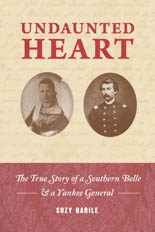Eno Publishers, 2009[/box]
 This is a love story describing the marriage of a Union General (Smith Dykins Atkins) to a Southern Belle, Ella Swain in the immediate aftermath of the Civil War. The couple met during the final stages of the war as Atkins’ brigade under Judson Kilpatrick occupied Chapel Hill, North Carolina. Swain, the 22 year old daughter of Dr. David Swain, a three time governor of North Carolina and President of the University of North Carolina met Atkins as a result of her father’s prominent role in surrendering the state to General Sherman. Following a whirlwind romance the couple became engaged within two months and married two months after that. The relationship was widely disapproved of and caused a great deal of controversy within the defeated southern community.
This is a love story describing the marriage of a Union General (Smith Dykins Atkins) to a Southern Belle, Ella Swain in the immediate aftermath of the Civil War. The couple met during the final stages of the war as Atkins’ brigade under Judson Kilpatrick occupied Chapel Hill, North Carolina. Swain, the 22 year old daughter of Dr. David Swain, a three time governor of North Carolina and President of the University of North Carolina met Atkins as a result of her father’s prominent role in surrendering the state to General Sherman. Following a whirlwind romance the couple became engaged within two months and married two months after that. The relationship was widely disapproved of and caused a great deal of controversy within the defeated southern community.
The book follows the married life of Swain and Atkins and ends with their deaths. In the text we are treated to snippets of the couple’s life through letters and written commentaries of contemporaries. We experience the joys of birth and the despair of death within their families. We learn that a good portion of their married life is spent between Freeport, Illinois where he is the postmaster appointed by Abraham Lincoln and a succession of republican presidents and North Carolina. The book provides limited insight into reconstruction and the affairs of the University of North Carolina.
The author, Suzy Barile, is a direct descendent of the Swain family and the publication of this story had been an unrealized family goal prior to the completion of this 167 page double spaced book. Endnotes, an index and bibliography provide some contextual material to help evaluate the book. Barile is an award winning writer who has contributed to several historical compendiums. The letters are in her personal possession and the project took approximately 15 years to culminate in this book.
Undaunted Heart is an easy read with a useful set of photographs that personalize the players; however, the book is flawed in its construction which is disjointed and hard to follow. The role of an editor is to fold in connective material and to fill in gaps to provide a cogent narrative. This is sadly lacking. The reader drifts from episode to episode without knowing where they are or what is happening within the larger societal context.
Early on the book shows promise of a meaningful insight into history of the University of North Carolina and the Chapel Hill community. Opposition to the match fits the reader’s expectation of confusion and hostility in the wake of the collapse of the Confederacy. Knowing that the purpose of the book is to tell the story of the love of these two people, allowance can be made for that oversight but the book is less for its absence. Equally disappointing is the lack of a solid family narrative although it is hard to know if sufficient documentation exists within the family’s archives to support such a discussion.
Another lost opportunity comes with the family’s move and life in Freeport, Illinois. The central role of the letters lends credibility to the effort; however, there is no editorial support to hold each of these important letters in context. Clearly, Atkins is a man of considerable importance and intellect and his wife is an educated and intelligent woman—the letters are ample evidence of that. Thus it is puzzling why the more experienced readers credited by the editor did not take a more active role to assist Barile in creating a better narrative.
It is not fair to criticize the representation of historical facts and as far as they go—only one egregious instance was noted, the editor is clearly not a Civil War or military historian and they don’t pretend to be. As to more relevant analysis several examples are representative of the criticisms of this tome. Sadly, the mortality rate of the Atkins children was exceptionally high—in one instance the editor talks about “Second Summer Disease.” The description is rather shallow and with the benefit of 140 years of medicine since the child died the editor could have and should have consulted with medical specialists and provided a stronger analysis. The problem sounds very much like lactose intolerance; but, that is not mentioned.
The other frustrating trait of the book is the disorganized presentation of the births and deaths of individuals and children without any chronological perspective. In 18 pages Mrs. Atkins goes from age 26 to 38 and is dead—3 other people are born and 10 die or their deaths are discussed. Yet the first 120 pages of the book cover but 28 months of her married life and family affairs.
This book accomplishes its primary purpose of sharing the evidence of this important 19th century relationship. It could have been much more. As a general read I can recommend it; however, as a useful historical resource it is clearly wanting.
[box]Reviewed by Len Riedel, Executive Director, BGESAvailable for purchase from Eno Publishers[/box]
